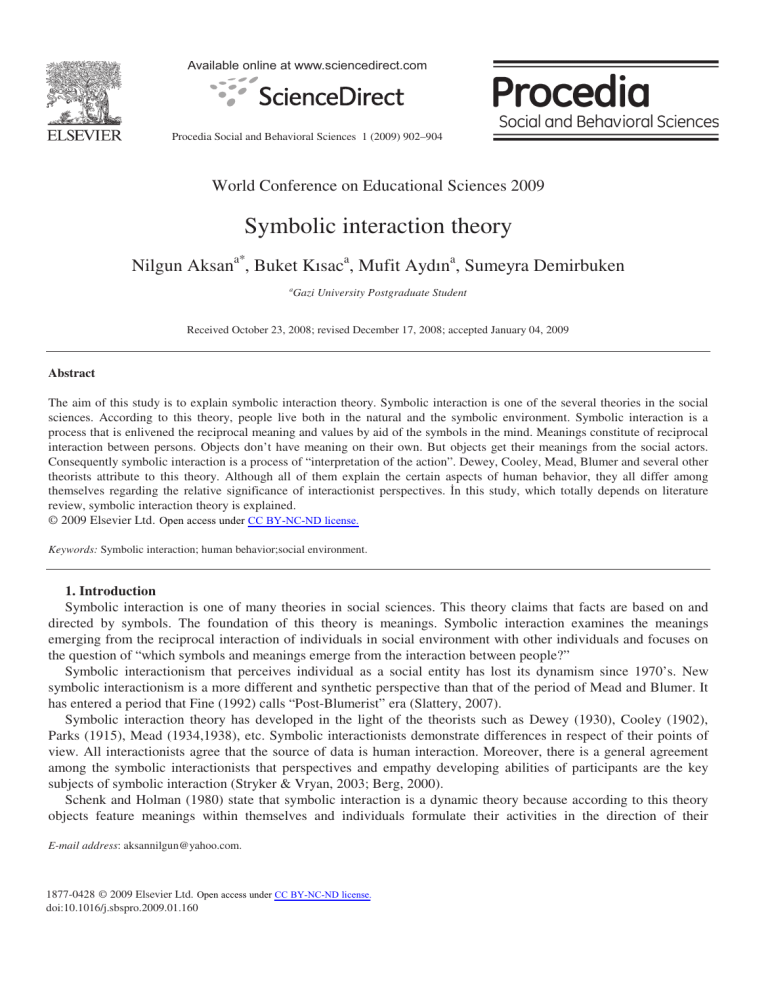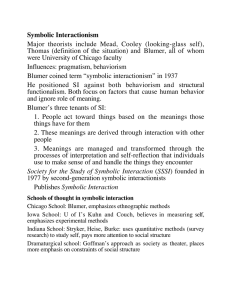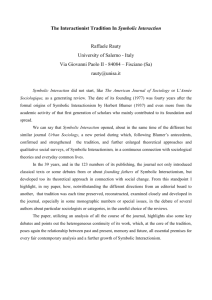Symbolic interaction theory world conferences on educational science2009
advertisement

Available online at www.sciencedirect.com Procedia Social and Behavioral Sciences 1 (2009) 902–904 World Conference on Educational Sciences 2009 Symbolic interaction theory Nilgun Aksana*, Buket Kısaca, Mufit Aydına, Sumeyra Demirbuken a Gazi University Postgraduate Student Received October 23, 2008; revised December 17, 2008; accepted January 04, 2009 Abstract The aim of this study is to explain symbolic interaction theory. Symbolic interaction is one of the several theories in the social sciences. According to this theory, people live both in the natural and the symbolic environment. Symbolic interaction is a process that is enlivened the reciprocal meaning and values by aid of the symbols in the mind. Meanings constitute of reciprocal interaction between persons. Objects don’t have meaning on their own. But objects get their meanings from the social actors. Consequently symbolic interaction is a process of “interpretation of the action”. Dewey, Cooley, Mead, Blumer and several other theorists attribute to this theory. Although all of them explain the certain aspects of human behavior, they all differ among themselves regarding the relative significance of interactionist perspectives. øn this study, which totally depends on literature review, symbolic interaction theory is explained. © 2009 Elsevier Ltd. Open access under CC BY-NC-ND license. Keywords: Symbolic interaction; human behavior;social environment. 1. Introduction Symbolic interaction is one of many theories in social sciences. This theory claims that facts are based on and directed by symbols. The foundation of this theory is meanings. Symbolic interaction examines the meanings emerging from the reciprocal interaction of individuals in social environment with other individuals and focuses on the question of “which symbols and meanings emerge from the interaction between people?” Symbolic interactionism that perceives individual as a social entity has lost its dynamism since 1970’s. New symbolic interactionism is a more different and synthetic perspective than that of the period of Mead and Blumer. It has entered a period that Fine (1992) calls “Post-Blumerist” era (Slattery, 2007). Symbolic interaction theory has developed in the light of the theorists such as Dewey (1930), Cooley (1902), Parks (1915), Mead (1934,1938), etc. Symbolic interactionists demonstrate differences in respect of their points of view. All interactionists agree that the source of data is human interaction. Moreover, there is a general agreement among the symbolic interactionists that perspectives and empathy developing abilities of participants are the key subjects of symbolic interaction (Stryker & Vryan, 2003; Berg, 2000). Schenk and Holman (1980) state that symbolic interaction is a dynamic theory because according to this theory objects feature meanings within themselves and individuals formulate their activities in the direction of their E-mail address: aksannilgun@yahoo.com. 1877-0428 © 2009 Elsevier Ltd. Open access under CC BY-NC-ND license. doi:10.1016/j.sbspro.2009.01.160 Nilgun Aksan et al. / Procedia Social and Behavioral Sciences 1 (2009) 902–904 903 evaluation of themselves and also people and objects around them. Thus, it is the social actors that attribute meaning to objects according to this perspective. The most important theorist of symbolic school is George Herbert Mead. Mead is a pragmatist and anti-dualist philosopher. He believes that mind and ego are products of society. Mead assumes that symbols develop mind and they are used as means for thinking and communication (Ashworth, 2000). Mead focused on how people interact in their daily lives by means of symbolic interaction and how they create order and meaning (Korgen & White, 2008). Blumer, who is a student of Mead, is the first one to use symbolic interaction term. For that reason he is also named as the founder of symbolic interaction. According to Blumer (1969) human forms “meaning” in two ways: (1) Meaning is something attributed to objects, events, phenomenon, etc. (2) Meaning is a “physical attachment” imposed on events and objects by human. Blumer believes that meaning is a condition that emerges as a result of the interaction of group members and not an intrinsic feature of the object (Tezcan, 2005). Consequently, meaning is created as a result of the interaction between people, and meaning allows people produce some of the facts forming the sensory world. These facts are related to how people form meaning. Thus, fact consists of the interpretation of various definitions. Thomas (1928) says “it is not important whether interpretation is accurate or not”. He believes that fact is based on personal perceptions and changes in time (Berg, 2000). There are three core principles in symbolic interaction perspective of Blumer: Meaning, language (language provides means [symbols] for debating meaning) and thinking principle. Symbolic interaction theory acknowledges the principle of meaning as the center of human behavior. Language provides a meaning to humans by means of symbols. It is symbols that differentiate social relations of humans from the level of communication of animals. Human beings give meaning to symbols and they express these things by means of language. Consequently, symbols form the basis of communication. In other words, symbols are indispensable elements for the formation of any kind of communication act. As the last principle in the symbolic interaction perspective thinking changes the interpretation of individuals pertaining to symbols (Nelson, 1998). Symbolic interaction is based on three basic propositions according to Blumer (Poloma, 1999: 224-225; Tye & Tye, 1992: 36); (a) Humans develop their attitudes towards things according to the meanings that things propose to them. (b) These meanings are inferred from the “interaction of one of them from its addressees”. (c) These meanings change within an interpretive process. Objects, humans, conditions and events don’t feature an intrinsic meaning. Meaning is attributed to these elements by means of human interaction. For instance; a video player in a college can be defined as a means of education utilized in order to demonstrate educational videos by the professor. If a student uses this video player in order to watch the films that he/she has rented, then it is defined as a source of entertainment and enjoyment. Similarly, for people in a jail watching the films sent by their families, this device shall be defined as the window opening to the outer world (Berg, 2000). As it can be understood from this example, humans form meaning as a result of their own experiences. These experiences are not random or unrelated. Symbolic interaction is a process including the interpretation of actions because symbolic meanings might be formed differently for anyone. For instance, students see a professor while walking towards their classes on the first day of the semester. They think that this professor is the kind of a professor that sermonizes, distributes extracts, divides curriculum, discusses the requirements of the course and conducts traditional first day activities. However, this professor is a “so-called” professor. A few students suspect and want to see identification card of the professor. As long as the professor goes on playing the role of educator the students continue their own roles within certain limitations as well. Assume that the class realized that the person assumed to be a professor is a dog collector that doesn’t have any academic certificate. The question after this awareness would be whether the reality of class experience for the past weeks is valid or not (since the dog collector has been perceived as a professor. Thus, he has been interpreted wrongly). Information reflected correctly by the dog collector helped fulfillment of roles expected by students. According to Thomas, these students defined the reality as the whole class (Berg, 2000; Nelson, 1998). There are certain criticisms directed towards symbolic interactionist paradigm. One of these criticisms is that symbolic interactionism is largely deprived of a real social envision. øn other words, symbolic interactionism doesn’t put forward a society picture or theory. Since it sometimes describes society as a thing only in the minds of people (Slattery, 2007). This theory, as also stated by Udehn (2001), is an “American” idea that stresses the freedom of the individual and limited role of the society. 904 Nilgun Aksan et al. / Procedia Social and Behavioral Sciences 1 (2009) 902–904 The second one of the problems of the symbolic interactionist paradigm is stressed especially and clearly: (i) not taking into account human emotions very much and (ii) getting interested in social structure to a limited extent. In fact, the first one of these two incompetencies implies that symbolic interaction is not completely psychological and the second one implies that symbolic interaction is not completely sociological (Meltzer et al, 1975: 120; Akt: Slattery, 2007: 338). This theory pictures meaning as something emerging by itself during interaction under a certain condition. It doesn’t take into account the basic social context in which the interaction is positioned. Consequently, it doesn’t produce the sources of meaning. Moreover, symbolic interactionism doesn’t perceive any social reality beyond the one that humans create with their interpretations and for that reason it denies explaining society on a more general level (Slattery, 2007: 338). In summary, the principal condition for the formation of a meaning is the existence of an event. The following condition is the experience of these events. As Blumer points out; “the meaning of things directs action” (O’Shaughnessy, 1992: 158). In order to understand human behaviors, it is necessary to understand definitions, meaning and processes formed by humans first. Elements such as social roles, traditional structures, rules, laws, purposes, etc. provide raw material to the individuals for forming definitions. In this context, symbolic interaction stresses social interaction, debate of definitions and taking emphatic role between people. References Alci, B. & Altun, S. (2007). Lise ogrencilerinin matematik dersine yonelik oz duzenleme ve bilisustu becerileri, cinsiyete, sinifa ve alanlara gore farklilasmakta midir?”. C.U. Sosyal Bilimler Enstitusu, Cilt: 16, Sayi: 1, sf. 33-44. Ashworth, P.D. (2000). Psychology and ‘human nature’. Routledge. Barnard, L., W.Y.Lan, S.M. Crooks & V.O. Paton (2008). The relationship between epistemological beliefs and self regulated learning skills on the online course environment. MERLOT Journal of Online Learning and Teaching, Vol: 4, No: 3, pp. 261-66. Berg, B.L. (2000). Qualitative research methods for the social sciences. Allyn & Bacon. Hess, B.B. (1988). Sociology. Allyn & Bacon. Korgen, K. & J.M. White (2008). Engaged sociologist: connecting the classroom to the community. Pine Forge Press. Nelson, L.D. (1998). Herbert Blumer’s symbolic interactionism. Avaliable at: http://www.colorado.edu/Communication/metadiscourses/Papers/App_Papers/Nelson.htm O’Shaughnessy, J. (1992). Explaining buyer behaviour: central concepts and philosophy of science issues. Oxford University Press. Poloma, M. (1993), Cagdas Sosyoloji Kuramlari, Istanbul: Gundogan Yayinlari. Schenk, C.T., ve Holman R.H. (1980), “A Sociological Approach to Brand Choice: The Concept of Situational Self ømage”, Advances in Consumer Research, 7, 610-614. Stryker, S. & K.D. Vryan (2003). The symbolic interactionist frame. Handbook of Social Psycchology, Edt: J.D. Delamater, NewYork: Springer. Tezcan, M. (2005). Sosyolojik kuramlarda egitim. Ankara: Ani Yayincilik. Tye, B.B. & K.A. Tye (1992). Global education: a study of school change. Suny Press. Udehn, L. (2001). Methodological øndividualism: Background, History and Meaning. London and New York: Routledge.



